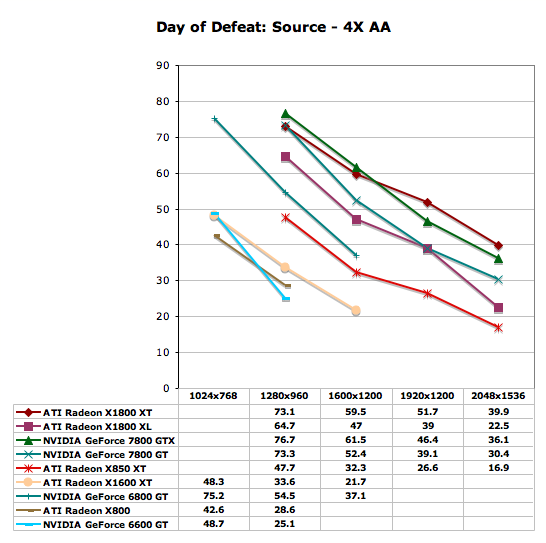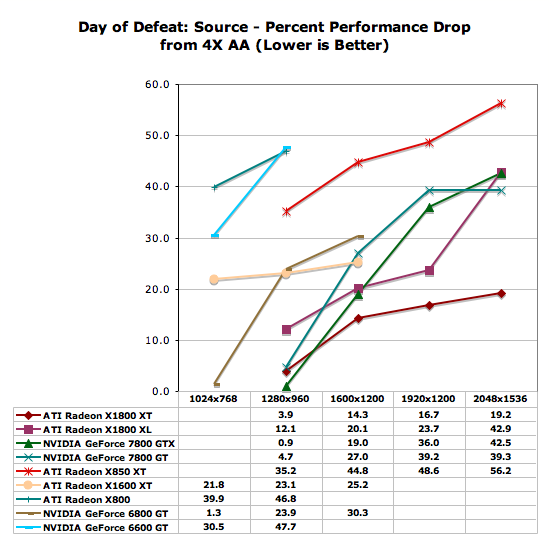ATI's X1000 Series: Extended Performance Testing
by Derek Wilson on October 7, 2005 10:15 AM EST- Posted in
- GPUs
Day of Defeat: Source Performance
Rather than test Half-Life 2 once again, we decided to use a game that pushed the engine further. The reworked Day of Defeat: Source takes 4 levels from the original game and adds not only the same brush up given to Counter Strike: Source, but HDR capabilities as well. The new Source engine supports games with and without HDR. The ability to use HDR is dependent on whether or not the art assets needed to do the job are available.
In order to push this test to the max, the highest settings possible were tested. This includes enabling the reflect all and full HDR options. Our first test was run with no antialiasing and trilinear filtering, and our second set of numbers was generated after 4x antialiasing and 8x anisotropic filtering were enabled.
From the looks of our graph, we hit a pretty hard CPU barrier near 80 frames per second. The 7800 GTX sticks the closest to this limit for the longest, but still can't help but fall off when pushing two to three megapixel resolutions. The 7800 GT manages to out-perform the X1800 XT, but more interestingly, the X850 XT and X1800 XL put up nearly identical numbers in this test. The X1300 Pro and the X1600 XT parallel each other as well, with the X1600 XT giving almost the same numbers as the X1300 Pro one resolution higher. The 6600 GT (and thus the 6800 GT as well) out-performs the X1600 XT pretty well.

Antialiasing changes the performance trends a bit, but at lower resolutions, we still see our higher end parts reaching up towards that 80 fps CPU limit. The biggest difference that we see here is that the X1000 series are able to gain the lead in some cases as resolution increases with AA enabled. The X1800 XT takes the lead from the 7800 GTX at 1920x1200 and at 2048x1536. The 7800 GT manages to hold its lead over the X1800 XL, but neither is playable at the highest resolution with 4xAA/8xAF enabled. The 6600 GT and X1600 XT manage to stop being playable at anything over 1024x768 with AA enabled. On those parts, gamers are better off just increasing the resolution to 1280x960 with no AA.

The 7800 series parts try to pretend that they scale as well as the X1800 series at 1600x1200 and below when enabling AA. The X850 XT scales worse than the rest of the high end, but this time, the X1600 XT is able to show that it handles the move to AA better than either of the X8xx parts test and better than the 6600 GT as well. The 6800 GT takes the hit from antialiasing better than the X1600 XT though.

Doom 3 showed NVIDIA hardware leading at every step of the way in our previous tests. Does anything change when looking at numbers with and without AA enabled?
Rather than test Half-Life 2 once again, we decided to use a game that pushed the engine further. The reworked Day of Defeat: Source takes 4 levels from the original game and adds not only the same brush up given to Counter Strike: Source, but HDR capabilities as well. The new Source engine supports games with and without HDR. The ability to use HDR is dependent on whether or not the art assets needed to do the job are available.
In order to push this test to the max, the highest settings possible were tested. This includes enabling the reflect all and full HDR options. Our first test was run with no antialiasing and trilinear filtering, and our second set of numbers was generated after 4x antialiasing and 8x anisotropic filtering were enabled.
From the looks of our graph, we hit a pretty hard CPU barrier near 80 frames per second. The 7800 GTX sticks the closest to this limit for the longest, but still can't help but fall off when pushing two to three megapixel resolutions. The 7800 GT manages to out-perform the X1800 XT, but more interestingly, the X850 XT and X1800 XL put up nearly identical numbers in this test. The X1300 Pro and the X1600 XT parallel each other as well, with the X1600 XT giving almost the same numbers as the X1300 Pro one resolution higher. The 6600 GT (and thus the 6800 GT as well) out-performs the X1600 XT pretty well.

Antialiasing changes the performance trends a bit, but at lower resolutions, we still see our higher end parts reaching up towards that 80 fps CPU limit. The biggest difference that we see here is that the X1000 series are able to gain the lead in some cases as resolution increases with AA enabled. The X1800 XT takes the lead from the 7800 GTX at 1920x1200 and at 2048x1536. The 7800 GT manages to hold its lead over the X1800 XL, but neither is playable at the highest resolution with 4xAA/8xAF enabled. The 6600 GT and X1600 XT manage to stop being playable at anything over 1024x768 with AA enabled. On those parts, gamers are better off just increasing the resolution to 1280x960 with no AA.

The 7800 series parts try to pretend that they scale as well as the X1800 series at 1600x1200 and below when enabling AA. The X850 XT scales worse than the rest of the high end, but this time, the X1600 XT is able to show that it handles the move to AA better than either of the X8xx parts test and better than the 6600 GT as well. The 6800 GT takes the hit from antialiasing better than the X1600 XT though.

Doom 3 showed NVIDIA hardware leading at every step of the way in our previous tests. Does anything change when looking at numbers with and without AA enabled?










93 Comments
View All Comments
bob661 - Friday, October 7, 2005 - link
Are they fully DX10 or partially? If partially, will that be enough to be Vista compliant?Clauzii - Friday, October 7, 2005 - link
I´m pretty amased that ATI despite the higher clockrate can acomplish almost the same as a 7800GTX although with 2/3 the Pipelinecapacity.I´ll look even more forward to R580.
MemberSince97 - Friday, October 7, 2005 - link
Ahh Thank You Derek, this is much more AT style.Madellga - Friday, October 7, 2005 - link
Derek, nice update. Thanks for including 1920x1200 in the benchmarks, it is a good move and I hope that other sites follow AT on that.It is interesting to see how the performance of some higher level cards fall after 1600x1200. Anyone buying WS monitors should pay attention to this.
I was not conviced that the X1800XT was better performer than the 7800GTX, but looking at the WS high resolutions and AA+AF that pretty much settles the discussion.
Don't let the critics bug you. Use it as feedback and source of ideas for future reviews.
On the next article, please do not forget to check the famous "shimmering" effect.
Does the R520 family handles this issue better than the G70?
Take care
JNo - Monday, October 10, 2005 - link
Well put! This is extremely helpful for 1920x1200 LCD ownerserinlegault - Friday, October 7, 2005 - link
I think important point that is missing from all reviews is the importance of a Vista compatible graphics crad. The x1xxx's are the first graphics cards compatible with the new spec.So the price premium may be worth while if you are interested in upgrading the Vista, when ever it is finally released.
bob661 - Friday, October 7, 2005 - link
All you need is DX9 to be Vista compatible.bob661 - Friday, October 7, 2005 - link
Oops, DX8.tfranzese - Friday, October 7, 2005 - link
From the article:Yet you guys tested none. I think benchmarking available versions of FEAR, Call of Duty 2, Serious Sam 2, Black and White 2, etc would be much more enteresting than some of the choices made here. All the cards tested handle todays games well, but I would expect most who buy these cards are buying these for games that are soon-to-be released or coming in the next one or two quarters.
karlreading - Friday, October 7, 2005 - link
i must admit it seems to me everyones just giving anadtech a hard time. the review seemed prtty reasonable, they responded to the massive backlash they got from there first review, and i think thats where the deserve the credit. sheesh guys! givem a break!karlos